The 1st Independent Polish Parachute Brigade
(1 Samodzielna Brygada Spadochronowa)
The Durhams
Of Largo House, Fife
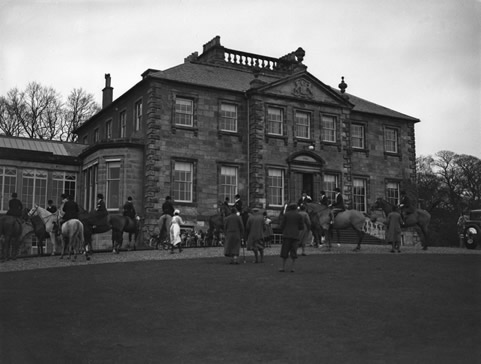 © St.Andrews University
© St.Andrews University
Sir Alexander Durham
Sir Alexander Gibson of Durie then sells the tower and original mansion in 1662 to Sir Alexander Durham (3rd son of Sir James Durham of Pitkerrow) for 85,000 merks, his family being a wealthy Fife family.
The original mansion and Sir Andrew Woods Tower remain for a further 90 years before the Durhams Of Largo House, Fife decided to do away with it.
Who was Sir Alexander Durham? He was a loyalist and was knighted by Charles II and appointed lord-lyon, king at arms in 1660. He was also a colonel of a regiment and...wait for it...a receiver-general of land taxes of Scotland.
So, plenty of money kicking about to run the place! Interestingly he then took a change of career and went on to study and become one of Scotlands first ministers. If you would like to know more about the Durhams ancestry go here: http://www.electricscotland.com/History/nation/durham.htm
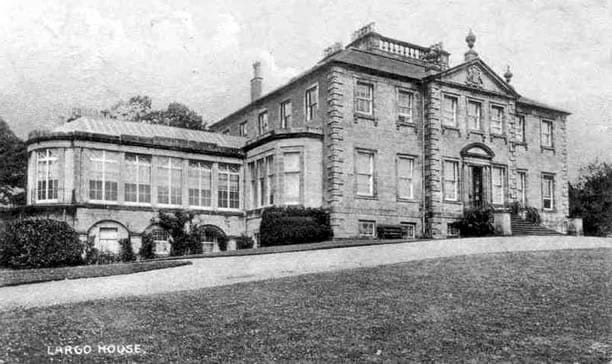 © www.swoopingeagle.com
© www.swoopingeagle.com
Sir Alexander Durham never married so when he died so when he died in 1663 he bequeathed the "lands of largo" to his nephew Francis (the son of his eldest brother, James of Pitkerrow, one of Glasgow's ministers aka The Reverend James Durham of Glasgow).
In 1667, Francis Durham died and was succeeded by his brother "James Durham Esq Of Largo"
James Durham Esq Of Largo (Married To Margaret Rutherford)
We are about to mention quite a few "James Durham's" here but bear with me, the lineage is good and comes from researching Burke's Genealogical and Heraldic History of the Landed Gentry, Volume 1.
So "James Durham Esq Of Largo" marries Margaret Rutherford and inherits the house in 1667 and in due course is married twice. His second wife is Anne Anstruther from whom arose his heir.
This heir was, wait for it.."James Durham" (yet another one!) to make matters worse he also took the title "James Durham Esq of Largo" and in time married Anne Calderwood.
James Durham Esq Of Largo (Married To Anne Calderwood)
So around 1750, James Durham (1732 - 1808) (the one married to Anne Calderwood!), demolishes the original mansion with Sir Andrew Woods Tower being retained. A new mansion is built that will soon be known as Largo House.
Notably, James Durham and his wife Anne Calderwood in 1754 had a son by the same name, "James Durham" who then went on to be known as "General James Durham". His younger brother, in turn, was "Sir Philip Charles Calderwood Durham" (born 1763), AKA "Admiral Durham", who would go on to fight distinguished Napoleonic wars.
Noting the date of birth of James Durham, he would have been shy of 18 years old when he commenced this. Either he was a very mature teenager or the dates recorded in history are slightly out!
However, when we consider that his brother Philip entered the Navy at age 14 it is maybe not so unusual to have made such a big decision early in life.
There is no verifiable detail on whether the completion date was 1750 or whether this is when the founding stone was set. As the stone over the front door has 1750 carved in it, based on customs at that time it is likely it was finished in 1750 with the building work commencing many years earlier.
Notably, on the triangular point one floor up (the"tympanum") from the front door is the Durham families coat of arms.
In 1815 the stable block at the rear was added. Then further alterations were undertaken including the addition of the 2 rear wings of the house, the conservatory, the Eagle Lodge and associated gate.
The ownership of Largo House changed because at one point "Mrs C Dundas Durham" was listed as being the owner of it. On other documents, "Mr D Dundas" was listed as owner of Largo House. Presumably, he died and she inherited it.
Interestingly, Mrs D Dundass is also listed as the owner of Kirkton of Largo Brewery whome brewed a strong Porter Ale then subsequently beer. Now I love Porter Ale, wish I could have tasted that one!
If you search for "Largo House" on this link you will come across many farms and business ventures of the Dundas family. Their power, wealth and influence in all areas of Largo was quite outstanding.
It starts to give you the feel of what Largo House was all about, a family who owned very considerable amounts of land, farms, forests, a brewery, a corn mill, a spinning mill (of 60 employees) and more.
Missing Detail 1750 - 1939
At the time of writing, we have no day to day history of Largo House up until 1940. Do you have any information? Please contact us if you do.
But we do have this wonderful photo taken during one of the many regular "Fife Foxhound" meets that happened at Cambo House (In Crail) and also at Largo House. This photo was taken at Largo House stables.
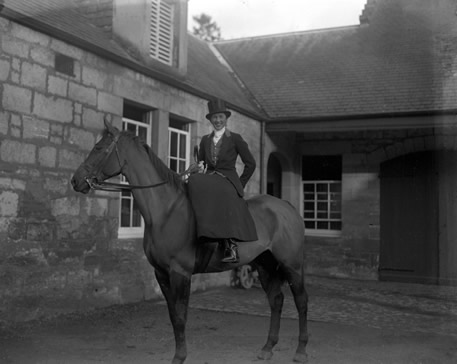 © St.Andrews University
© St.Andrews University
And here is another picture of the Fife Foxhounds meeting at Largo House:
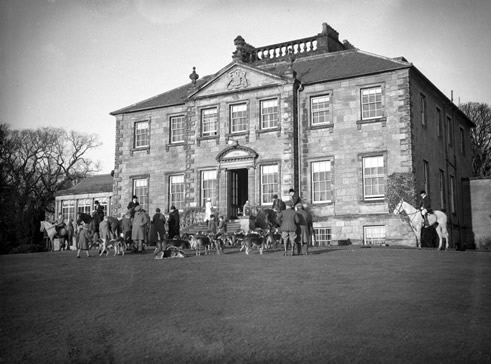 © St.Andrews University
© St.Andrews University
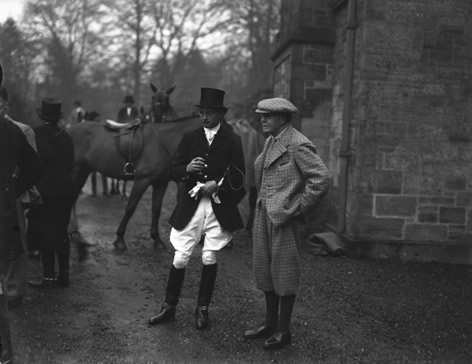 © St.Andrews University
© St.Andrews University
What we do know is that the house was a major employer in its day. In 1755 the population of the Parish of Largo was 1,396 and this grew to around 2,500 by 1951.
It's a fair guess that most families would have had a relative that worked or had worked at Largo House, whether in the house directly, on the estate or at one of the businesses or farms they owned.
We would love to have any info or photos of the people that worked there.
Pre World War 2 - An Empty Mansion
The fortunes and heyday of Largo House were about to change, very much for the worse, as World War 2 approached. Pictures of happy families and events at Largo House were about to become a distant memory as the drone of World War 2 planes came through the skies.
 © www.swoopingeagle.com
© www.swoopingeagle.com
Note the 3 people to the right of the car in this turn of the century photo. Looks like a photo session was happening. If only I could get hold of the rest of the photos from this set!
Prior to World War 2, property taxes were were reaching an all time high. Obtaining staff for large country houses was also proving increasingly difficult as the old way of life slowly ebbed away.
Even wealthy owners of large country mansions were divesting themselves of their properties in favour of smaller, more comfortable dwellings.
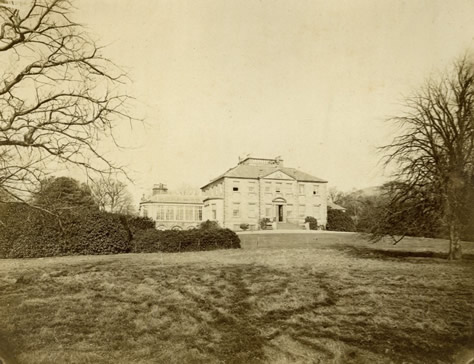 © St.Andrews University
© St.Andrews University
Therefore, hard as it is for us to comprehend, large houses were systematically abandoned throughout the UK. This became true of Largo House too, in 1939, the house was vacated, however it's empty state was only to last a few months...
Some Local History About Largo, Fife
Largo means "beside hill". The towns of Lower Largo and Upper Largo are literally that, situated beside "Largo Law" a local hill. Former names of Largo are: Largach, Largauch, Largath, and Largav.
A picturesque town, it's beaches were popular bathing places in summer with a steam-boat that went twice a day between Largo and Newhaven in the summer and once in the winter.
The industry in the area was farming as well as a mill, a brewery and the mining of aggregates. The "lands of largo: were therefore very profitable indeed and the Durham family controlled vast proportions of this.
From the above we can see that the Durham family exerted considerable local influence in Largo, therefore Largo House was, to some degree at one time, the epicentre of Largo.
Harbour
The harbour at the mouth of keil-burn area itself was greatly improved by General Durham to allow the steamboat to enter the harbour to embark and disembark passengers.
This was clearly a successful idea as the harbour came to have 3 boats that traded coal, salt, iron and sandstone with Campvere, Rotterdam and also wood to Norway.
Population
In 1831 there were only 479 houses in Largo with a population of 2,567. This means that there was an average of 5 people living in each house.
In 1881 records recount that there were 2 churches, a gas works, a post and telegraph office, a schoolhouse near the cemetery and a branch of the national bank.
Woods Hospital
One point that tickled me when I was researching this was that also in Upper Largo was Woods hospital (built by John Wood a descendant of Sir Andrew Wood who built the tower that was named after himself).
If your surname was Wood you could go to Woods hospital and get free medical care as well as an allowance of £15 plus a supply of vegetables whilst there. An interesting place to live it seems.
Please Donate!

Uncover The Past - Support The Future
Please don't "grab & go"! Each year, 12,000 people visit this website to trace their Polish ancestry, uncover family stories, and connect with their roots. I believe that history should be accessible to all - but keeping this website alive since 2017 comes at a personal cost to me, 8 years @ £1000 per year (website mgt fees) has left an £8000 dent...with only £380 in total donated up to 27/11/25 😱😱😱.
Every detail you uncover and every story you piece together helps you piece family history together. Please donate if you found the existing information on this site useful, help me keep the site alive! Thanks! Jason Nellyer (Researcher & Site Owner)